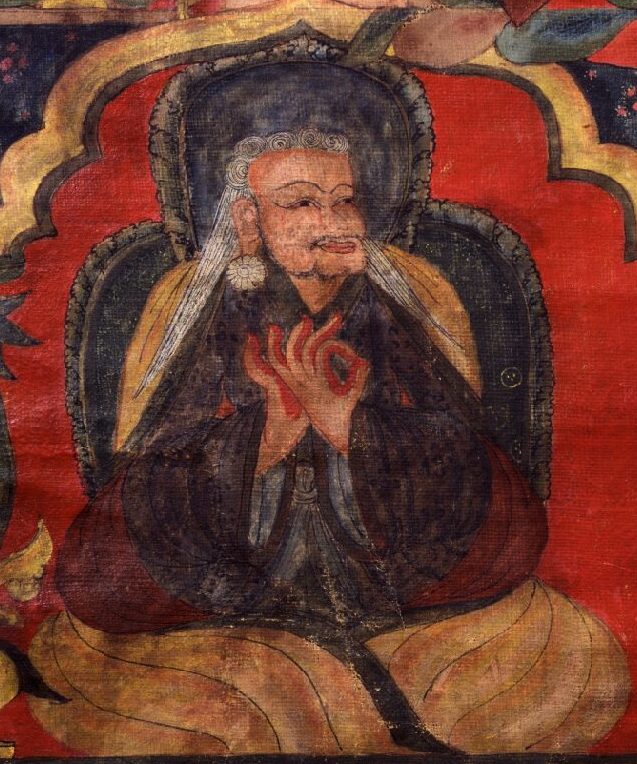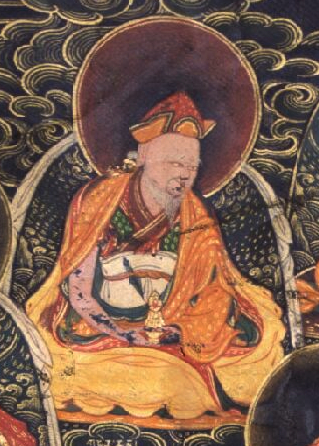Biography and autobiography in Tibet are important sources for both education and inspiration. Tibetans have kept such meticulous records of their teachers that thousands of names are known and discussed in a wide range of biographical material. All these names, all these lives—it can be a little overwhelming. The authors involved in the Treasury of Lives are currently mining the primary sources to provide English-language biographies of every known religious teacher from Tibet and the Himalaya, all of which are organized for easy searching and browsing. Every Tuesday on the Tricycle blog, we will highlight and reflect on important, interesting, eccentric, surprising and beautiful stories found within this rich literary tradition.
Part 1: Padmasambhava
Part 2: Dampa Deshek
Nyingma Founders, Part 3: Nyangrel Nyima Ozer
 In the 11th and 12th centuries the Kadam, Kagyu, Sakya, and other Sarma (“new translation”) traditions coalesced around new tantric texts brought to Tibet from India. Those who adhered to earlier translations, claiming to uphold the legacy of Buddhism that had come to Tibet during the Imperial Era of the 8th and 9th centuries, found themselves in a tough spot. The new translators argued that Buddhist practice in Tibet had deteriorated during the “age of fragmentation” following the collapse of central power in the 10th century, and called for the abandonment of most texts that came before their own new translations.
In the 11th and 12th centuries the Kadam, Kagyu, Sakya, and other Sarma (“new translation”) traditions coalesced around new tantric texts brought to Tibet from India. Those who adhered to earlier translations, claiming to uphold the legacy of Buddhism that had come to Tibet during the Imperial Era of the 8th and 9th centuries, found themselves in a tough spot. The new translators argued that Buddhist practice in Tibet had deteriorated during the “age of fragmentation” following the collapse of central power in the 10th century, and called for the abandonment of most texts that came before their own new translations.
Defenders of the early translations responded with two strategies, both of which eventually coalesced into the Nyingma—literally, “Ancient”—tradition. Clans like the Zur in central Tibet and masters such as Dampa Deshek (1122–1192) in eastern Tibet defended the lineages of texts that had, they claimed, been translated during the Imperial Era. These teachings came to be categorized as kama, or “spoken word.” Others devised an innovative method to bypass the problematic “age of fragmentation” and link their teachings directly to the Imperial Era: they claimed that masters of that age such as Padmasambhava and Vimalamitra had concealed scriptures in monasteries or even inside cliffs only to be recovered later. Having lain dormant through the “age of fragmentation,” the texts—known as terma, or “treasure”—could be deemed unsullied by that period’s corruptions.
One of the first Buddhists to employ this method of scriptural production, which was also practiced by Bon lineages, was Nyangrel Nyima Ozer (1124–1192). The treasure-revealing tradition depended on a vision of the Tibetan Imperial Period as a golden age of Buddhism, and Nyangrel, as a means of supporting his own revelations, made several important contributions to the development of this national mythology.
 Nyangrel Nyima Ozer was born in 1124 in Lhodrak, southern Tibet. His father, Nyangton Chokyi Khorlo, maintained tantric lineages that had been passed down in the Nyang family since imperial days. He gave his son a series of empowerments, including one for his life-long tutelary deity Hayagriva.
Nyangrel Nyima Ozer was born in 1124 in Lhodrak, southern Tibet. His father, Nyangton Chokyi Khorlo, maintained tantric lineages that had been passed down in the Nyang family since imperial days. He gave his son a series of empowerments, including one for his life-long tutelary deity Hayagriva.
During a retreat in his teenage years, Nyangrel recalled past lives that situated him in a line of incarnations beginning with the Tibetan Buddhist emperor Trisong Detsen (c.742–800) and continuing for 16 lives up to his own, thus cleverly grounding his future teachings in the Imperial Era. This was one of the earliest assertions of a distinct line of reincarnation, occurring well before the establishment of the Karmapa line in the Kagyu tradition.
Following the death of his father, Nyangrel left his homeland and sought teachings from other masters, including two who gave him basic spoken-word teachings relating to the tantric categories of Mahayoga, Anuyoga, and Atiyoga—or Dzogchen. He also met two lamas, Lama Rashak and Drubtob Ngodrub, who gave him empowerments from their treasure revelations and certificates that would lead him to reveal treasure of his own.
Nyangrel constructed a small hermitage at a relatively desolate place known as Mawochok, which became his seat. The early years were a financial struggle; he supported his practice by performing thread-cross and other rituals. According to his biographies, he remained at the site at the instruction of a series of visions, including one in which Padmasambhava gave him a key to treasures concealed very close to Mawochok.
At a nearby place called Drak Sinmobarje, he revealed his first cache of treasures, including the initial set of texts that, combined with those of Drubtob Ngodrun and of a later treasure revealer, became the Mani Kambum. This collection of narratives cast the early Tibetan emperor Songtsen Gampo (c.617–650) as an incarnation of the bodhisattva Avalokitesvara, a deity the texts elevated to the status of protector of Tibet and whose mantra, om mani pema hung, they promulgated.
Nyangrel’s later revelation of the Copper Palace, a biography of Padmasambhava, elevated the 8th-century figure to the status of Second Buddha. It created a lengthy narrative of Padmasambhava’s life before he came to Tibet, greatly expanded his role in the establishment of Buddhism in Tibet, and laid the foundation for the claim that Padmasambhava had concealed treasure across Tibet. It remains one of the most popular biographies of the man Tibetans know as Guru Rinpoche.
Nyangrel’s treasure revelations concluded around the time he reached the age of 50, and he spent the remainder of his life at Mawochok with his wife, Jobuma, and his disciples. Among those were his two sons, Namkha Ozer and Namkha Pel, to whom he transmitted both his family lineage and his treasure revelations. After several decades of teaching and retreat, Nyangrel passed away in 1192, at the age of 69. His reliquary survives at Mawochok.
Thank you for subscribing to Tricycle! As a nonprofit, we depend on readers like you to keep Buddhist teachings and practices widely available.